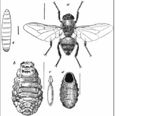Hypoderma spp.
Scientific Classification
| Kingdom | Animalia |
| Phylum | Arthropoda |
| Class | Insecta |
| Order | Diptera |
| Family | Oestridae |
| Genus | Hypoderma |
There are two important Hypoderma ssp. found in cattle, namely; H. bovis and H. lineatum. H. diana is also a parasite of clinical significance, affecting the deer population.
- Also known as warble flies
- Important cattle parasites
- Also parasitise horses, small ruminants and sometimes humans
- The two main species in cattle are
- H. bovis
- H. lineatum
- H. diana parasitises deer
- Infestation is largely confined to the Northern Hemisphere
Hypoderma bovis
| Also known as: | Warble fly
|
Identification
H. bovis are 15mm in length, and have a bumble-bee appearance. The abdomen is yellow, and there is a band of black hairs located down the middle. Large 13-15mm long.
Life Cycle
H. bovis lays single eggs on hairs around the lower legs of the host. The larvae develop and enter the body through the skin, where they migrate to the epidural fat found along the thoracic and lumbar vertebrae of the spine. The larvae stay here for the duration of the winter.
The larvae are palpable as distinct swellings, known as warbles.
Hypoderma lineatum
| Also known as: | Warble fly
|
Identification
H. lineatum are 13mm in length, and like H. bovis have a bee-like appearance.
Life Cycle
The eggs are laid in rows of around 6 on single hairs. The eggs then penetrate the skin and move along the connective tissue toward the diaphragm. They will continue to migrate, until they reach the oesphagus where the larvae will spend the duration of the winter. After 3 months larvae reach winter resting sites where they remain from November to February/March whilst moulting to the L2 stage.
Adult flies emerge on warm, sunny days between June and August. The adult lives for around 3 weeks.
Hypoderma diana
| Also known as: | Warble fly |
Identification
The adult H. diana is around 15mm in length and like boht H. bovis and H. lineatum.
Pathogenesis
- Causes myositis
- Production losses
- Condemnation and down-grading of hides
- Reduced milk yield and reduced weight gain
- Injury from stock panic
- Trimmed meat losses from H. lineatum
- 'Butcher's Jelly' around warbles which is green due to mass eosinophil attraction
- Paraplegia resulting from
- Toxin release
- Pressure on the spinal cord (H. bovis)
- Bloat from pressure on the oesophageal wall (H. lineatum)
Control
- Total eradication should be aimed for
- Old methods include popping out warbles
- But this could lead to anaphylactic shock
- Ectoparasiticides
- Systemic organophosphorus insecticides in pour-on formula
- Avermectins and milbemycins in pour-on and injectible formulations
- Timing is crucial for treatment
- Larvae residing in winter resting sites, if killed, can lead to bloat and paraplegia
- It is safe to treat in the autumn before larvae reach their winter resting sites and in the spring when the warbles have migrated to the midline of the back
- Ivermectin can be given at any time without risking host infection as larval antigen is released much slower
Legislation in the UK
- 'Warble Fly Order 1978' requires all clinically affected animals to be treated
- Notifiable disease
- 'Warble Fly Infected Area Order 1983'
- For more information on the warble fly orders, see here
in cattle
- May occasionally burrow into muscle
